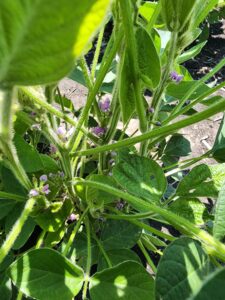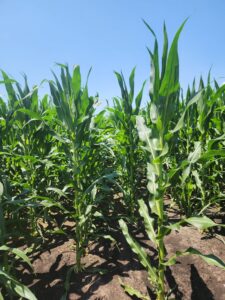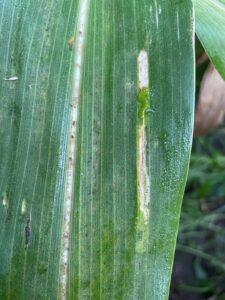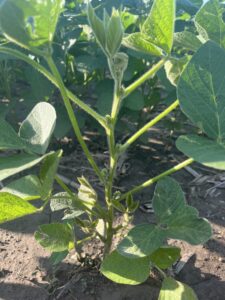Illinois Crop Update – July 19, 2024
Emily Hansen – Commercial Agriculture Educator
LaSalle County
Soil Conditions: Near Normal
LaSalle County experienced a good amount of precipitation this week from the several large storm systems that moved through the area. Luckily, we have not seen any severe damage from these storms. I also have not noticed much standing water in fields. Corn at the IVCC + Extension plots is tasseling or getting close to it. Soybeans are flowering. The IVCC + Extension plots are a little behind in development compared to fields in a lot of LaSalle County. Corn in many fields is tasseling, silking, or has been successfully pollinated.

Figure 1: Soybeans at IVCC + Extension plots

Figure 2: Corn at IVCC + Extension plots
Russ Higgins – Commercial Agriculture Educator
Grundy County
Soil Conditions: Mildly Wet (soil is wetter than normal, local vegetation is healthy
An active week on the weather front in northeast Illinois. Several storms packing high winds roared through the area. Despite this, to date, I have heard few reports of down corn. Regional corn fields are at varied maturities because of planting dates. The earliest planted has reached R2 (blister), the developing kernels appear as clear fluid containing whitish blisters on the cob, silks are brown and drying rapidly. Most soy is also at R2 (full bloom) and closing canopies in 30″ rows. Fungicide applications are underway by plane, helicopter and drone (and likely ground rigs when field conditions permit). I noted isolated incidence of gray leaf spot and tar spot this week, I plan on revisiting those corn fields within the week to reassess. On some corn plants, lower leaves exhibit the inverted V symptoms of nitrogen deficiency. Leaf senescence occurs naturally and is identified by corn leaves losing greenness due to a reduction in chlorophyll. Not all nutrients are lost, some assimilates are “remobilized” and transferred to the ear and kernels so that grain fill can be sustained and completed. While a natural process, lower leaf senescence and its counterpart, top dieback, can also be initiated by crop stresses and bears watching in future field visits.

Figure 3: Disease update – GLS and tar spot

Figure 4: Nutrient deficiency/remobilization

Figure 5: Brown silk stage
Reagan Tibbs – Commercial Agriculture Educator
Logan County
Soil Conditions: Mildly Wet (soil is wetter than normal, local vegetation is healthy)
Monday night’s derecho brought significant rainfall to the area. Most parts of Logan, Menard, and Sangamon counties received 1.5 to nearly 3 inches of rain. This rain, combined with the rain received from Hurricane Beryl, caused some low-lying areas to have standing water. Thankfully, there does not appear to be any signs of wind damage. Nearly all of the corn across the three counties has tasseled, and pollination is beginning. Soybeans also look good, almost all in the R2 to R3 stages. Waterhemp continues to be a prevalent issue. Japanese beetles are also present, but damage has yet to reach the economic threshold in the fields I have walked through.

Figure 6: Japanese beetle on a soybean leaf in Logan County.
Talon Becker – Commercial Agriculture Specialist
Coles County
Soil Conditions: Moderately Wet (soil is damp, standing water may be present in low
areas, water bodies are full)
Compared to my last trip around Coles County at the end of May, conditions are considerably wetter now in mid-July with an estimated 5-6 inches of rain since the beginning of the month, according to the Midwest Regional Climate Center. Most fields are at or near water holding capacity, and although not widespread, standing water could be seen in areas of low-lying fields at the time of this survey (7/16). That said, much of the corn and soybean crop still looked healthy and will likely continue that way if the current forecast holds, and no significant rainfall is experienced in the area over the next 5-7 days. Most corn fields were at least showing tassels, and the furthest advanced fields were around R2. Most soybean fields are somewhere around R2-R3 with a few stragglers still in late vegetative or early reproductive stages. I saw one field of double-crop soybeans emerged and at V1-2. Insect damage still appears to be minimal, but Japanese beetles and some corresponding defoliation (<5%) were seen in a number of soybean fields. Except for in the areas of standing water, disease symptoms were also minimal at the time of the survey. Although if wet conditions persist, that may change in the coming weeks.

Figure 7: Standing water present in some low-lying fields, with visible yellowing occurring soybeans

Figure 8: Estimated accumulated precipitation (in.) across Illinois in the month of July – Midwest Regional Climate Center

Figure 9: Corn at R2 (blister) stage
Dane Hunter – Commercial Agricultural Specialist
St. Clair County
Soil Conditions: Mildly Wet (soil is wetter than normal, local vegetation is healthy)
Southern Illinois is wet. Southern Illinois University Carbondale’s Belleville Research Center has measured over 12″ of rain so far in July, with less than 6″ coming Monday of this week. Fields that aren’t flooded are still heavily waterlogged. Most corn fields are at VT/Silking. About a quarter of fields were still in vegetative stages and one field with browning silks, but that was an outlier. First crop soybeans are either starting to flower or are fully in R2 already. Double crop soybeans are V3-V4 and trying to get above the wheat stubble.

Figure 10: First crop soybeans at R2

Figure 11: First crop soybeans starting R1

Figure 12: Double crop soybeans at V4





